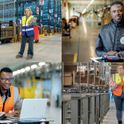
His predictions about a revolution in communications technology and that people, regardless of location, would be able to connect and work together in real time became reality. However, despite this, the desire for direct human interaction has grown, with approximately 70% of the world population forecast to live in urban areas by 2050, and with rail journeys in the UK, for example, doubling over the last 20 years. Fast and reliable transport connectivity, both within and between urban areas, is essential for the movement of people and goods, acting as economic arteries and ensuring geographical distribution of growth.
Looking ahead, long distance, inter-urban transport will continue to rely on proven and safe technologies such as air and high-speed rail, although platooning of autonomous vehicles on motorway sections will emerge in the medium term. The lead-in times for major infrastructure to support these travel modes is still measured in decades and so it is important that policy makers remain committed to long-term strategies that transcend short-term political cycles and not be unduly distracted by new technologies. For example, the common chord among the most transformative initiatives like Hyperloop technology is that they start with vision and a recognition that they have a way to go until they might be accepted as cost effective, efficient and safe means of mass public transportation. The DfT Science Advisory Council cited that operational viability of Hyperloop, if achieved, is at least 20 years away.
It is urban transport which is likely to undergo the biggest change in the next 20 years and the challenge for city leaders is to lay down the frameworks which allow this development to take place. City congestion, whether it is by road or rail, is at an all-time high. Road incidents, whilst declining, continue to take their terrible toll. Air pollution is an increasing concern and carbon reduction targets are encouraging policy makers to promote alternative travel means. The phase-out of diesel and petrol car sales by 2040 and the growth in hybrid and all-electric vehicles, the latter particularly so with improving battery technologies, are increasingly offering viable alternatives to the internal combustion engine, which in time will seem as antiquated as the horse and carriage does today.
It is the ascendancy of autonomous vehicles that will have the biggest impact on how we travel over the next 30 years. Many new cars are fitted with some level of automation and this will increase, initially disrupting the taxi industry as companies introduce an autonomous fleet. Further development will see a decline in car ownership as it becomes possible to dial-up a vehicle on demand, providing a door-to-door pick-up and drop-off service.
This growth in autonomous vehicles will significantly impact how our roads are organised and used. With less potential for error, vehicles will be able to run closer to each other, resulting in increased road capacity. In the longer term there will be less need for road signage and complex interchanges as vehicles connect to each other and the world around them.
This transition to autonomous vehicles will not happen overnight and various commentators see this change evolving over the next 30 years. The big challenge for urban planners is to design infrastructure for shared use whilst at the same time supporting, and indeed encouraging, increasing autonomous usage and technological developments.
This future of transport will depend more and more upon digital infrastructure, leveraging the power of new, disruptive technology to find a better way. Each autonomous vehicle will create approximately 1Tb of data per hour and will communicate with others around it, roadside sensors and central servers. This has enormous implications for local data storage and associated energy requirements. Assuming that privacy, security and ownership issues can be addressed, the resultant data will provide many, as yet unimagined solutions to transport and infrastructure asset management. For example, by deploying advanced analytics and machine learning to enable multimodal agility and data-driven investments. Asset owners will be able to better assess their most critical system needs, make more intelligent decisions for infrastructure delivery and implement changes that promote increased efficiency and ease of use. Combine machine learning with the Internet of Things (sensors) and smart asset management principles and real time, highly reliable predictive traffic management results across the network. Going further, combining blockchain technology with data generated by autonomous vehicles opens up new possibilities for road pricing.
Mr Clarke’s prophecy centred on the impact that better communication would have on the need for physical connectivity. However, it is the digital connectivity upon which this communication depends that is offering up revolutionary changes in how we travel. The technologies exist and so it is only now a matter of time before this future of transport is realized.












